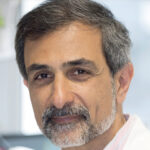About
Adult muscle satellite (stem) cells are quiescent during homeostasis. We showed that Notch signaling is highest in quiescent muscle satellite cells, and this activity drops dramatically before the first cell division after muscle injury and during the generation of myoblasts for muscle repair (4). High Notch signaling levels are then restored as muscle stem cells self-renew and assume cellular quiescence. Interestingly, loss of function of Rbpjk and hence Notch signaling results in a break in cellular quiescence of the muscle stem cells and it promotes their differentiation. How this happens is intriguing – during homeostasis, the majority bypass S-phase DNA replication and perform a direct G0 quiescence to G1 differentiation transition (4; Figure 1). However, following cell cycle entry after muscle injury, removal of Rbpj activity leads to muscle cell proliferation.
We generated a transgenic Tg:Pax7-nGFP mouse that marks muscle stem cells from the embryo to the adult. We identified a novel dormant stem cell state during cellular quiescence that corresponds to lower metabolic activity, higher expression of stem cell genes and a longer lag before the first mitosis (5). These dormant cells are found within the Pax7-nGFPHigh subpopulation (about 10% of total stem cell population). Interestingly, in collaboration with the laboratory of Dr. Fabrice Chrétien, we showed that post mortem muscle stem cells adopt this novel dormant stem cell state under these severe environmental conditions (anoxia, necrosis), and those isolated from the mouse retain regenerative potential after transplantation into regenerating muscle (6).



Figure 1. Notch signaling maintains the muscle stem cell quiescent state. Top: Quiescent satellite cells uptake BrdU and differentiate under normal conditions; Bottom: In the absence of Notch signaling, the majority of muscle stem cells break quiescence and differentiate without undergoing DNA replication (4). Right: Inducible RBPJ-binding model in response to Notch signaling activation. Upon receptor activation and cleavage, the intracellular domain of Notch (NICD; green) translocates into the nucleus, where it binds RBPJ (red). We propose that NICD interacts with RBPJ off the DNA and subsequently is recruited to the ‘‘inducible’’ targets to activate gene expression (black arrow). In the absence of NICD, RBPJ complexed with corepressors is weakly bound or not bound at all to DNA on those sites (dashed arrows). In contrast, NICD-independent RBPJ is statically bound to the ‘‘constant’’ sites, when Notch signaling activity is modulated. Constant sites contain the same RBPJ-binding motif as the inducible sites; hence, binding is likely to be specified by diverse partners (gray circle). (Castel, Mourikis, Bartels et al. Genes & Dev. 2013).

